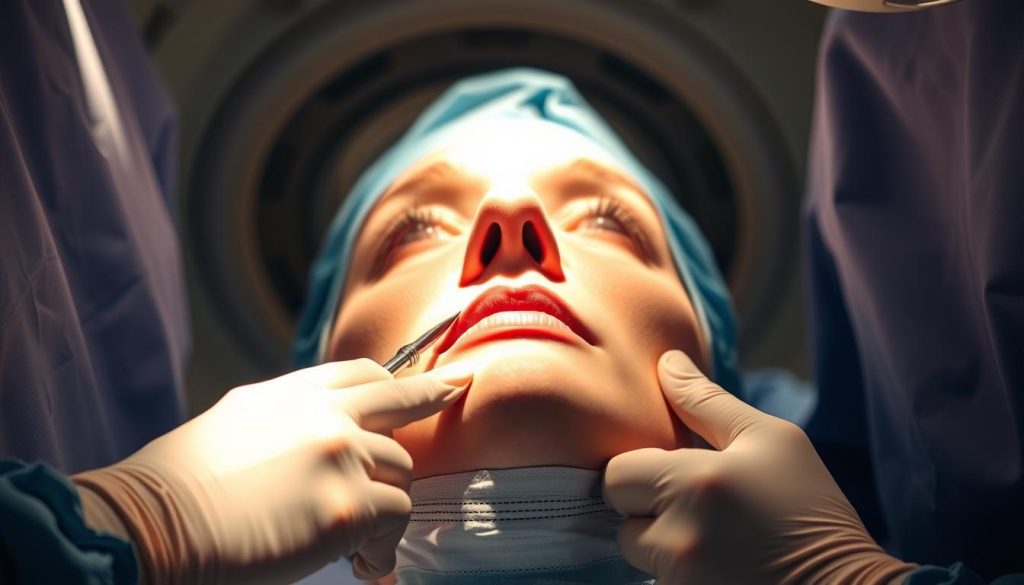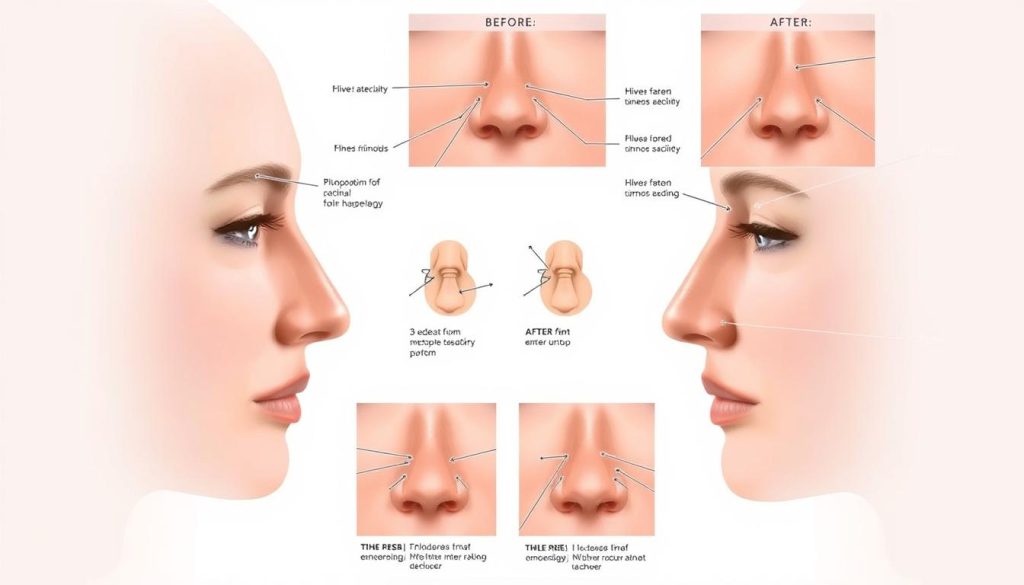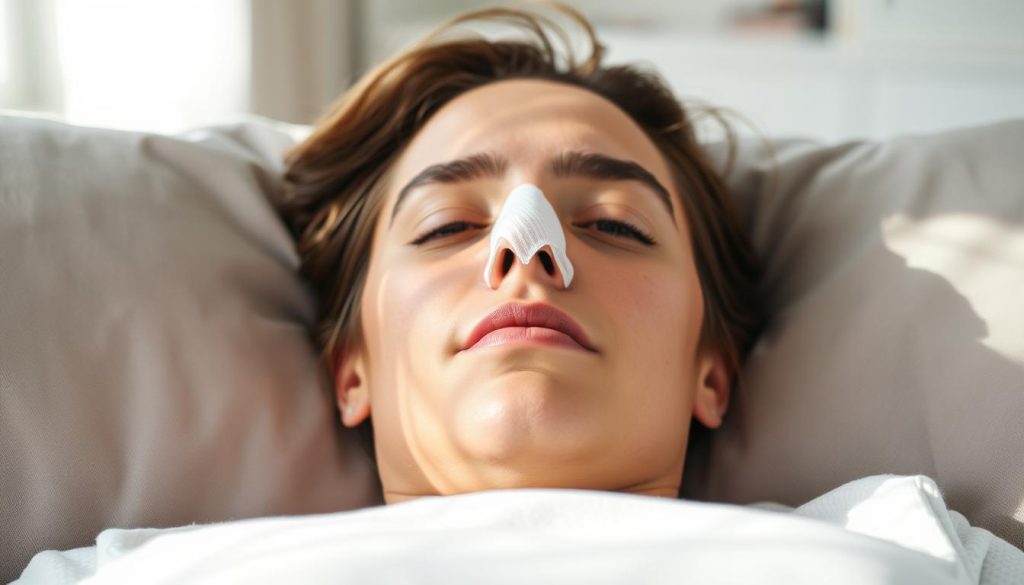Rhinoplasty, commonly known as nose plastic surgery, is a popular cosmetic surgery procedure aimed at reshaping and restructuring the nose to achieve facial harmony and potentially improve breathing function.
This comprehensive guide will explore the various aspects of rhinoplasty, including the procedure, recovery expectations, and potential risks involved. By understanding the full scope of rhinoplasty, individuals can make informed decisions about undergoing this surgery.
Key Takeaways
- Rhinoplasty is a surgical procedure that reshapes and restructures the nose.
- It can address both aesthetic concerns and functional issues, such as breathing difficulties.
- Modern rhinoplasty techniques provide more natural-looking results with shorter recovery times.
- A successful rhinoplasty requires careful planning, skilled surgical execution, and proper post-operative care.
- Understanding the procedure, risks, and recovery is crucial for potential patients.
- Rhinoplasty can modify nose size, shape, and proportion to create facial harmony.
Understanding Nose Plastic Surgery
Rhinoplasty, a surgical procedure aimed at reshaping the nose, has become a popular choice for individuals seeking to improve their nasal appearance or function. This nuanced facial plastic surgery procedure can address a wide range of nasal concerns, from aesthetic issues to functional problems.
What is Rhinoplasty?
Rhinoplasty, commonly known as a “nose job,” is a surgical procedure designed to reshape, resize, or reconstruct the nose for cosmetic or functional purposes. The procedure can address various nasal concerns, such as reducing a prominent bump on the bridge, refining a bulbous tip, or correcting asymmetry. Beyond aesthetic improvements, rhinoplasty can correct structural abnormalities that impair breathing, such as a deviated septum or collapsed nasal valves.

Common Reasons for Seeking Nose Surgery
Individuals seek nose surgery for various reasons, including dissatisfaction with their natural nose shape, addressing changes from aging, correcting injuries, and resolving breathing difficulties. The ideal candidate for rhinoplasty should have completed facial growth and be in good overall health. Understanding the limitations of rhinoplasty is crucial; the procedure aims to improve upon the existing nose rather than delivering “perfection” or replicating someone else’s nose.
| Reasons for Nose Surgery | Description |
|---|---|
| Dissatisfaction with Nose Shape | Correcting the size or shape of the nose for aesthetic purposes |
| Breathing Difficulties | Improving nasal function to enhance breathing |
| Injury Correction | Reconstructing the nose after a traumatic injury |
Types of Rhinoplasty Procedures
Understanding the different types of rhinoplasty is crucial for making an informed decision. Rhinoplasty, or nose surgery, encompasses various techniques tailored to individual needs and desired outcomes.

Open Rhinoplasty
Open rhinoplasty involves making a small incision across the columella, the tissue between the nostrils. This approach provides surgeons with direct visualization of nasal structures, allowing for greater precision in complex cases. It is particularly beneficial for significant reshaping, correction of asymmetry, or revision procedures.
Closed Rhinoplasty
Closed rhinoplasty utilizes incisions entirely within the nostrils, leaving no visible external scarring and potentially reducing swelling and recovery time. This approach is often suitable for less complex cases where minor refinements are needed.
Tiplasty
Tiplasty focuses exclusively on reshaping the nasal tip without altering other structures. It is appropriate for patients whose only concern is the appearance of the nasal tip.
Non-Surgical Rhinoplasty
Non-surgical rhinoplasty uses injectable dermal fillers to temporarily modify the nose shape without incisions. It offers immediate results with minimal downtime and can be used to camouflage bumps, improve symmetry, or refine the nasal tip.
Each rhinoplasty approach has distinct advantages and limitations. The optimal technique depends on the patient’s anatomy, aesthetic goals, and functional needs. Consulting with a qualified surgeon is essential to determine the most suitable procedure.
The Consultation Process
The consultation process is a pivotal moment in rhinoplasty, allowing patients to communicate their desires and understand the procedure’s intricacies. During this initial meeting, the surgeon will assess the patient’s nose and facial structure to determine the feasibility of their goals.
What to Expect During Your Initial Consultation
During the consultation, the surgeon will conduct a thorough examination of your nasal structures, facial proportions, and skin quality. This assessment is crucial for understanding the potential outcomes of the rhinoplasty procedure. The surgeon will also review your medical history to identify any conditions that could impact the surgery or recovery.
Advanced 3D imaging technology may be used to create visual simulations of potential results, helping you better understand the proposed changes. This technology serves as a valuable communication tool, ensuring that both you and your surgeon are aligned on the goals and expected results.
Preparing for Your Consultation
To make the most of your consultation, it’s advisable to come prepared with a list of your medications and supplements, specific concerns about your nose, and realistic expectations about potential outcomes. Bringing reference photos can also be helpful, though your surgeon will emphasize achieving results that complement your unique facial features.
| Preparation Step | Description |
|---|---|
| List Medications | Bring a list of your current medications and supplements to discuss potential interactions. |
| Share Concerns | Clearly communicate your concerns and expectations regarding your nose and facial structure. |
| Bring Reference Photos | Reference images can help your surgeon understand your aesthetic preferences. |
Using 3D Imaging to Visualize Results
3D imaging allows for a more informed discussion about the potential outcomes of your rhinoplasty. This technology provides a visual representation of how your nose might look after surgery, helping to set realistic expectations and ensure that you and your surgeon are working towards the same goals.
The Nose Plastic Surgery Procedure

Undergoing rhinoplasty involves a series of meticulous steps, from preparation to post-operative care. The procedure is typically performed as an outpatient surgery, allowing patients to return home the same day.
Anesthesia Options
Rhinoplasty can be performed under general anesthesia or local anesthesia with intravenous sedation. The choice of anesthesia depends on the complexity of the procedure and patient preference.
Step-by-Step Surgical Process
The surgical process begins with carefully placed incisions, either inside the nostrils for a closed approach or with an additional small incision across the columella for an open approach. The surgeon then gently lifts the skin to expose the underlying cartilage and bone structure.
The nasal bones and cartilage are then precisely modified to achieve the desired shape or to correct functional issues such as a deviated septum.
Duration and Immediate Post-Op Care
Most rhinoplasty procedures take between one to three hours, depending on the complexity of the surgery. Immediately after the procedure, patients are monitored in recovery and then discharged with specific care instructions and pain medication.
Internal packing and external splints may be used to support the newly shaped nose during the initial healing process.
Recovery Timeline After Rhinoplasty
Understanding the recovery process after rhinoplasty surgery is crucial for patients to manage their expectations and ensure a smooth healing journey. The recovery timeline can be broken down into several stages, each with its own characteristics and milestones.
First Week After Surgery
The first week after rhinoplasty surgery is typically the most challenging. Patients often experience swelling and bruising around the eyes and nose, as well as congestion due to internal swelling and possible nasal packing. To manage discomfort and reduce swelling, patients are advised to sleep with their head elevated, apply cold compresses, and take prescribed medications. A small plastic splint is usually worn on the nose to minimize swelling and maintain its new shape during the initial healing process.

Weeks 2-4: Initial Healing
Between weeks 2-4, most visible bruising resolves, and the majority of external swelling subsides. This allows patients to comfortably return to work and social activities. However, it’s essential to continue avoiding strenuous activities, wearing glasses that rest on the nose bridge, and situations that risk nasal injury. The splint is typically removed at the one-week follow-up appointment, along with any external stitches.
Months 1-3: Diminishing Swelling
From months 1-3, the nose continues to refine as internal swelling gradually diminishes. Approximately 90% of all swelling is resolved by the three-month mark. Patients may notice their nose looking different in the morning versus the evening due to fluid retention patterns.
Complete Recovery (Up to 1 Year)
Complete recovery can take up to a full year, as the final 10% of subtle swelling slowly resolves and the nose settles into its permanent shape. The tip of the nose typically retains swelling the longest, gradually becoming more defined over the months following surgery. Patience is essential during the recovery process, as the final results emerge gradually rather than immediately after splint removal.
Potential Risks and Complications
It’s essential for individuals contemplating rhinoplasty to be informed about the possible risks and complications associated with the surgery. While generally considered safe, rhinoplasty, like any other surgery, carries potential risks that can impact the outcome and recovery process.
Common Side Effects
Common side effects following rhinoplasty include temporary swelling, bruising, nasal congestion, minor bleeding, and mild to moderate discomfort. Most patients experience numbness in the nasal tip for several weeks to months as nerve sensation gradually returns to normal. Difficulty breathing through the nose is expected initially due to internal swelling but should improve progressively as healing advances.
Serious Complications to Be Aware Of
More serious complications, though rare, can include infection, adverse reaction to anesthesia, excessive scarring, or persistent breathing problems requiring revision surgery. Patients with unrealistic expectations may experience psychological dissatisfaction even with technically successful outcomes.
Asymmetrical Healing
Asymmetrical healing is a common occurrence where swelling affects one side of the nose more than the other, creating a temporarily crooked appearance. This uneven swelling typically resolves on its own over time and does not indicate a surgical error or permanent asymmetry. Patients with a history of deviated septum correction may be more prone to asymmetrical healing.
Achieving Successful Results From Your Rhinoplasty
To achieve the desired outcome from nose reshaping, it’s crucial to have realistic expectations and a skilled surgeon who can deliver the results you desire.
The results of rhinoplasty surgery are permanent, making the choice of a qualified surgeon paramount. By reshaping nasal structures, a cosmetic surgeon can help achieve various goals, such as straightening a crooked nose or refining the size of a bulbous nasal tip.
Key factors contributing to successful rhinoplasty results include selecting a board-certified plastic surgeon, maintaining realistic expectations, and following pre-operative and post-operative instructions meticulously. Additionally, protecting your nose from sun exposure during recovery and being patient as the final results refine over time are crucial.
FAQ
What is the difference between open and closed rhinoplasty?
Open rhinoplasty involves making an incision between the nostrils, allowing for greater visibility and access to the nasal structure. Closed rhinoplasty, on the other hand, involves making incisions within the nostrils, resulting in less visible scarring.
How long does it take to recover from rhinoplasty?
The initial recovery period typically lasts one to two weeks, during which time patients may experience swelling, bruising, and discomfort. It can take several months for the swelling to fully subside and the final results to become apparent.
Can rhinoplasty improve breathing problems?
Yes, rhinoplasty can be used to correct a deviated septum or other nasal obstructions that may be causing breathing difficulties. This is often performed in conjunction with other procedures, such as septoplasty or turbinate reduction.
What are the risks associated with rhinoplasty?
As with any surgical procedure, rhinoplasty carries risks such as bleeding, infection, and adverse reactions to anesthesia. Additionally, there is a risk of unsatisfactory results, including asymmetry or scarring.
Can I use fillers as an alternative to rhinoplasty?
Non-surgical rhinoplasty using fillers can be a viable alternative for some patients, particularly those seeking minor adjustments to the nasal tip or bridge. However, fillers are not a suitable replacement for surgical rhinoplasty in cases where significant changes are desired.
How is the nasal tip reshaped during rhinoplasty?
The nasal tip can be reshaped by modifying the underlying cartilage and bone structure. This may involve reducing or augmenting the tip, or reorienting the cartilage to achieve a more aesthetically pleasing shape.
What is the role of 3D imaging in rhinoplasty?
3D imaging technology allows patients to visualize their potential results before undergoing surgery. This can help to facilitate a more informed discussion between the patient and surgeon regarding the desired outcome.
Can rhinoplasty be performed under local anesthesia?
While some rhinoplasty procedures can be performed under local anesthesia with sedation, others may require general anesthesia. The choice of anesthesia will depend on the complexity of the procedure and the patient’s individual needs.
